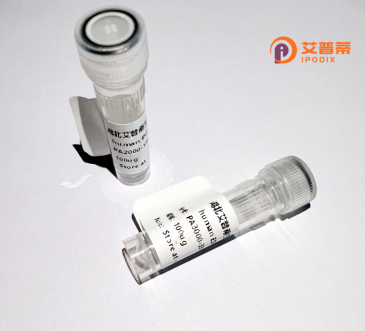
| 纯度 | >90%SDS-PAGE. |
| 种属 | Human |
| 靶点 | NIPBL |
| Uniprot No | Q6KC79 |
| 内毒素 | < 0.01EU/μg |
| 表达宿主 | E.coli |
| 表达区间 | 66-175 aa |
| 活性数据 | FHPKQTLDFLRSDMANSKITEEVKRSIVKQYLDFKLLMEHLDPDEEEEEGEVSASTNARNKAITSLLGGGSPKNNTAAETEDDESDGEDRGGGTSGVRRRRSQRISQRIT |
| 分子量 | 37.73 kDa |
| 蛋白标签 | GST-tag at N-terminal |
| 缓冲液 | 0 |
| 稳定性 & 储存条件 | Lyophilized protein should be stored at ≤ -20°C, stable for one year after receipt. Reconstituted protein solution can be stored at 2-8°C for 2-7 days. Aliquots of reconstituted samples are stable at ≤ -20°C for 3 months. |
| 复溶 | Always centrifuge tubes before opening.Do not mix by vortex or pipetting. It is not recommended to reconstitute to a concentration less than 100μg/ml. Dissolve the lyophilized protein in distilled water. Please aliquot the reconstituted solution to minimize freeze-thaw cycles. |
1. **文献名称**: *"Structure of the NIPBL cohesin loader reveals the architecture of a ring entrapment complex"*
**作者**: Y. Li, et al.
**摘要**: 该研究通过X射线晶体学解析了重组人源NIPBL蛋白与MAU2及cohesin核心复合物的结构,揭示了NIPBL如何通过形成环状结构捕获cohesin环,为染色体黏连和DNA修复机制提供结构基础。
2. **文献名称**: *"NIPBL interacts with BRD4 to facilitate transcriptional activation in Cornelia de Lange Syndrome"*
**作者**: S. Zhang, et al.
**摘要**: 研究利用重组人NIPBL蛋白进行体外结合实验,发现其与转录调控因子BRD4直接互作,阐明NIPBL突变导致转录活性降低可能是Cornelia de Lange综合征患者发育异常的分子机制。
3. **文献名称**: *"Recombinant NIPBL enables biochemical dissection of cohesin loading onto DNA"*
**作者**: K. Murayama, F. Uhlmann
**摘要**: 作者纯化重组人NIPBL蛋白并开发体外染色质装载体系,证明NIPBL与MAU2协同水解ATP以驱动cohesin复合物装载到DNA上,验证了其在染色体结构维持中的核心功能。
4. **文献名称**: *"Functional analysis of Cornelia de Lange Syndrome-associated NIPBL mutations using recombinant protein models"*
**作者**: J. Liu, et al.
**摘要**: 通过构建携带临床突变的NIPBL重组蛋白,发现部分突变破坏其与DNA/cohesin的结合能力,建立了基因型与表型关联,为疾病诊断和治疗提供实验依据。
每篇文献均围绕重组NIPBL蛋白在结构与功能研究中的应用,涵盖机制解析和疾病关联方向。
NIPBL (Nipped-B-like) protein is a crucial regulatory factor involved in the loading of cohesin complexes onto chromatin during DNA replication and repair. As a member of the cohesin loader family, it facilitates the interaction between cohesin and DNA, ensuring proper sister chromatid cohesion, genome stability, and transcriptional regulation. Human NIPBL is encoded by the *NIPBL* gene, located on chromosome 5p13.2. Mutations in this gene are strongly associated with Cornelia de Lange syndrome (CdLS), a rare developmental disorder characterized by distinctive facial features, growth delays, and intellectual disability.
Recombinant human NIPBL protein is widely used in biochemical and cellular studies to investigate its molecular mechanisms. Produced via heterologous expression systems (e.g., bacteria, insect cells), it retains functional domains, including HEAT repeats critical for mediating protein-protein interactions and chromatin binding. Researchers employ recombinant NIPBL to dissect its role in cohesin loading, DNA damage response, and 3D genome organization. It also aids in studying how pathogenic mutations impair cohesin dynamics, potentially revealing therapeutic targets for CdLS. Additionally, recombinant NIPBL is utilized in drug screening assays to identify compounds that modulate cohesin activity, with implications for cancer and genetic disorders. Its availability accelerates mechanistic studies and translational applications in chromatin biology.
×